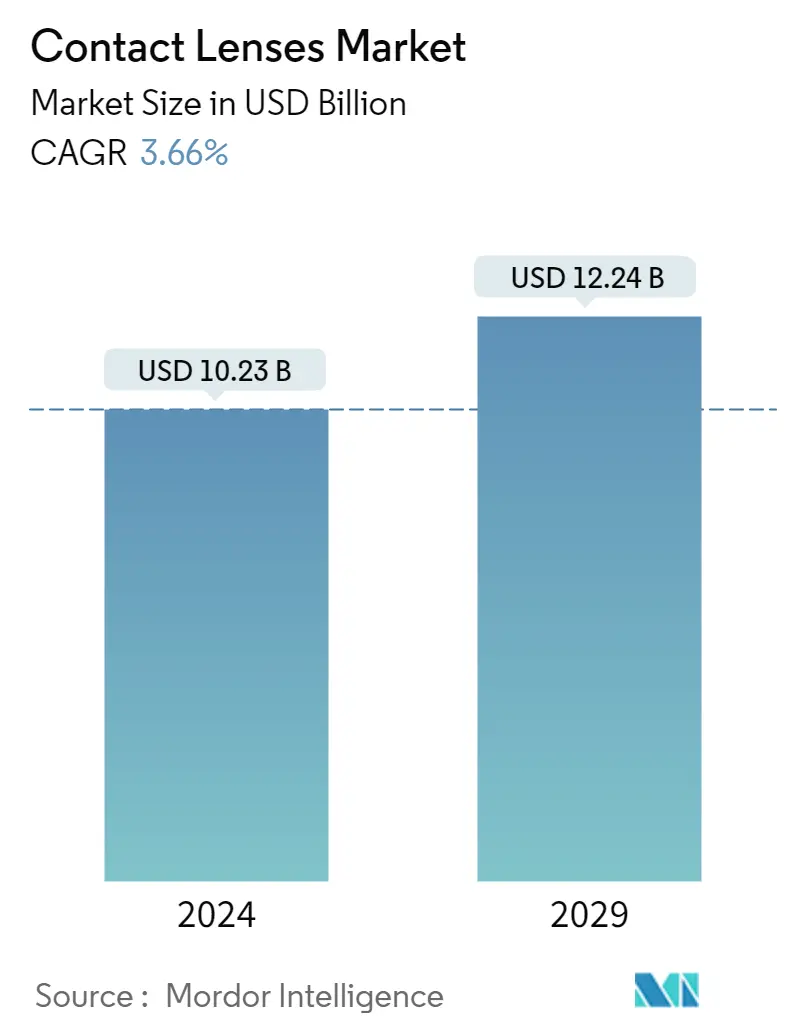Market Size of Contact Lenses Industry

| Study Period | 2021 - 2029 |
| Market Size (2024) | USD 10.23 Billion |
| Market Size (2029) | USD 12.24 Billion |
| CAGR (2024 - 2029) | 3.66 % |
| Fastest Growing Market | Asia-Pacific |
| Largest Market | North America |
Major Players
*Disclaimer: Major Players sorted in no particular order |
Contact Lenses Market Analysis
The Contact Lenses Market size is estimated at USD 10.23 billion in 2024, and is expected to reach USD 12.24 billion by 2029, growing at a CAGR of 3.66% during the forecast period (2024-2029).
The COVID-19 pandemic significantly impacted the market studied as a result of fewer eye care consultations due to the decrease in footfall in hospitals and clinics. For instance, according to the American Academy of Ophthalmology data published in August 2020, there was a nearly 80% initial decrease in ophthalmology visits. As of mid-June, there was still a cumulative decrease in ophthalmology visits by 40% in the United States. According to an article published by Optometry Times Journal in January 2021, the outbreak of the COVID-19 pandemic in 2020 led to a decrease in preference for contact lens usage. A significant factor behind this was to avoid touching the face and eyes as there was a risk of infection from the SARS-CoV-2 virus. This led to a decrease in demand for contact lenses during the pandemic. The increased risk of mask-associated dry eye (MADE), insufficient blinking, and decreased blink rate brought on by prolonged computer use are additional factors that contributed to the discontinued use of contact lenses. However, with the large-scale vaccinations and decreasing number of COVID-19 cases, the contact lenses market is expected to grow significantly during the forecast period.
The growth of the contact lenses market is also attributed to the rising prevalence of optical disorders, the rising tendency to improve aesthetics, and increasing disposable incomes. For instance, according to the October 2022 update of the WHO, about 2.2 billion people worldwide suffer from near or distant vision impairment. The primary causes of vision impairment are uncorrected refractive errors and cataracts. The same source also mentioned that the prevalence of distance vision impairment in low- and middle-income regions was estimated to be four times higher compared to high-income regions. The prevalence of unaddressed near vision impairment was estimated to be greater than 80% in western, eastern, and central sub-Saharan Africa. Comparative rates in high-income regions of North America, Australasia, Western Europe, and Asia-Pacific are reported to be lower than 10%. Thus, these regions may emerge as significant growth regions for the contact lenses market over the forecast period. Hence, the increasing burden of optical disorders is expected to play a crucial role in the growth of the contact lenses market over the forecast period.
The growing senior population further aggravates the prevalence of ophthalmic disorders. For instance, according to the June 2021 report of the BrightFocus Foundation, glaucoma affected more than 3 million Americans, with the most common kind, open-angle glaucoma, affecting 2.7 million people aged 40 and older. According to the same source, glaucoma will affect over 111 million people by 2040, leading to an increasing burden of glaucoma worldwide. Thus, the contact lenses market is expected to grow as glaucoma is one of the primary causes of vision loss worldwide.
Furthermore, optometry and optics have observed a significant increase in R&D activities. Some recent advancements in the market studied, such as developing dynamic soft contact lenses with advanced technology, propelled the growth of the contact lenses market globally. For instance, in January 2021, SyngergEyes Inc. launched the next generation of hybrid contact lenses named SynergEyes iD. Eye care professionals across the United States and Canada have successfully prescribed SynergEyes iDhybrid lenses to patients suffering from astigmatism and presbyopia. Hence, the numerous product launches are further contributing to the growth of the market studied.
However, factors such as the availability of alternative techniques and complications associated with lenses are likely to hamper the growth of the market studied.
Contact Lenses Industry Segmentation
A contact lens is a thin plastic or glass lens fitted over the eye's cornea to correct vision problems such as myopia, hyperopia, or astigmatism. Contact lenses not only serve the need to alleviate the use of hard-to-manage and bulky spectacles but also provide the added benefit of enhancing one's aesthetic appeal.
The contact lenses market is segmented by product type, usage, modality, design, and geography. By product type, the market is segmented into soft contact lenses, hybrid contact lenses, rigid gas permeable contact lenses, and other product types. By usage, the market is segmented into corrective contact lenses, therapeutic contact lenses, cosmetic contact lenses, and prosthetic contact lenses. By modality, the market is segmented into conventional and disposable. By design, the market is divided into spherical, toric, multifocal, and other designs. The report also covers the estimated market sizes and trends for 17 countries across major regions, such as North America, Europe, Asia-Pacific, Middle East and Africa, and South America. The report provides revenues and market forecasts in terms of value in USD million for the above segments.
| Product Type | |
| Soft Contact Lenses | |
| Hybrid Contact Lenses | |
| Rigid Gas Permeable Contact Lenses | |
| Other Product Types |
| Usage | |
| Corrective Contact Lenses | |
| Therapeutic Contact Lenses | |
| Cosmetic Contact Lenses | |
| Prosthetic Contact Lenses |
| Modality | |
| Conventional | |
| Disposable |
| Design | |
| Spherical | |
| Toric | |
| Multifocal | |
| Other Designs |
| Geography | ||||||||
| ||||||||
| ||||||||
| ||||||||
| ||||||||
|
Contact Lenses Market Size Summary
The contact lenses market is poised for growth, driven by factors such as the increasing prevalence of optical disorders, a rising inclination towards aesthetic enhancements, and growing disposable incomes. The market experienced a setback during the COVID-19 pandemic due to reduced eye care consultations and a decline in contact lens usage, as concerns over face and eye contact heightened. However, with the easing of pandemic-related restrictions and the rollout of vaccinations, the market is expected to recover and expand. The demand for contact lenses is further bolstered by the aging population, which is more susceptible to ophthalmic disorders like glaucoma, and advancements in optometry and optics, including the development of dynamic soft contact lenses.
North America is anticipated to hold a significant share of the market, supported by a high prevalence of ophthalmic disorders and increased consumer awareness. The region's growth is further fueled by numerous product launches and strategic initiatives by key market players. The competitive landscape is marked by the presence of major companies such as Essilor International SA, Bausch Health Companies Inc., and The Cooper Companies, which contribute to the market's dynamic nature. Innovations and regulatory approvals, such as those by Johnson & Johnson Vision and Alcon, are expected to drive the market forward, addressing the rising demand for corrective lenses and enhancing the overall market growth trajectory.
Contact Lenses Market Size - Table of Contents
-
1. MARKET DYNAMICS
-
1.1 Market Overview
-
1.2 Market Drivers
-
1.2.1 Increasing Burden of Optical Disorders
-
1.2.2 Increasing Tendency to Enhance Aesthetics
-
-
1.3 Market Restraints
-
1.3.1 Availability of Alternative Techniques and Complications Associated with Lenses
-
1.3.2
-
-
1.4 Industry Attractiveness - Porter's Fives Forces Analysis
-
1.4.1 Threat of New Entrants
-
1.4.2 Bargaining Power of Buyers/Consumers
-
1.4.3 Bargaining Power of Suppliers
-
1.4.4 Threat of Substitute Products
-
1.4.5 Intensity of Competitive Rivalry
-
-
-
2. MARKET SEGMENTATION (Market Size by Value - USD million)
-
2.1 Product Type
-
2.1.1 Soft Contact Lenses
-
2.1.2 Hybrid Contact Lenses
-
2.1.3 Rigid Gas Permeable Contact Lenses
-
2.1.4 Other Product Types
-
-
2.2 Usage
-
2.2.1 Corrective Contact Lenses
-
2.2.2 Therapeutic Contact Lenses
-
2.2.3 Cosmetic Contact Lenses
-
2.2.4 Prosthetic Contact Lenses
-
-
2.3 Modality
-
2.3.1 Conventional
-
2.3.2 Disposable
-
-
2.4 Design
-
2.4.1 Spherical
-
2.4.2 Toric
-
2.4.3 Multifocal
-
2.4.4 Other Designs
-
-
2.5 Geography
-
2.5.1 North America
-
2.5.1.1 United States
-
2.5.1.2 Canada
-
2.5.1.3 Mexico
-
-
2.5.2 Europe
-
2.5.2.1 United Kingdom
-
2.5.2.2 Germany
-
2.5.2.3 France
-
2.5.2.4 Italy
-
2.5.2.5 Spain
-
2.5.2.6 Rest of Europe
-
-
2.5.3 Asia-Pacific
-
2.5.3.1 China
-
2.5.3.2 Japan
-
2.5.3.3 India
-
2.5.3.4 Australia
-
2.5.3.5 South Korea
-
2.5.3.6 Rest of Asia-Pacific
-
-
2.5.4 Middle East and Africa
-
2.5.4.1 GCC
-
2.5.4.2 South Africa
-
2.5.4.3 Rest of Middle East and Africa
-
-
2.5.5 South America
-
2.5.5.1 Brazil
-
2.5.5.2 Argentina
-
2.5.5.3 Rest of South America
-
-
-
Contact Lenses Market Size FAQs
How big is the Contact Lenses Market?
The Contact Lenses Market size is expected to reach USD 10.23 billion in 2024 and grow at a CAGR of 3.66% to reach USD 12.24 billion by 2029.
What is the current Contact Lenses Market size?
In 2024, the Contact Lenses Market size is expected to reach USD 10.23 billion.

